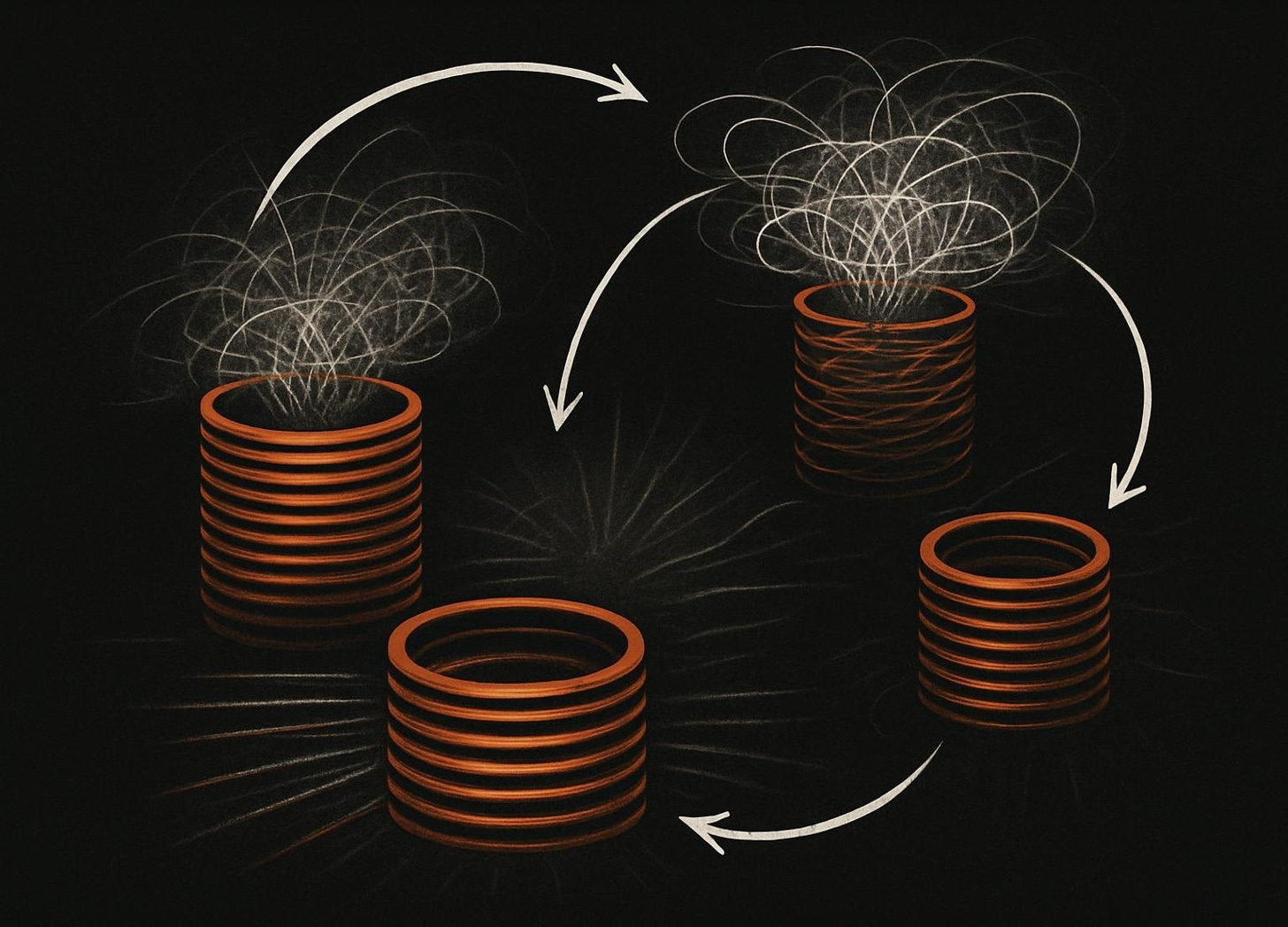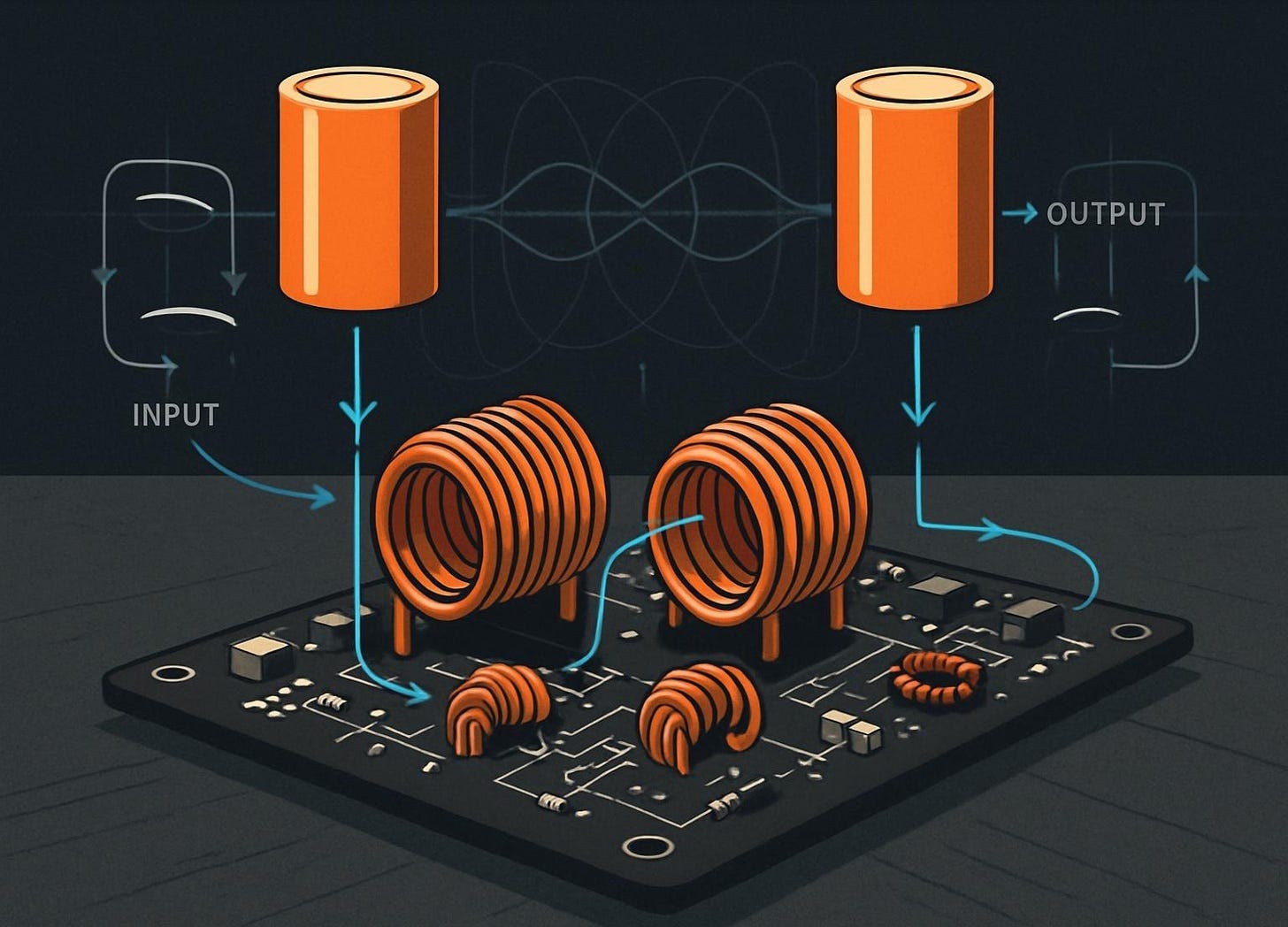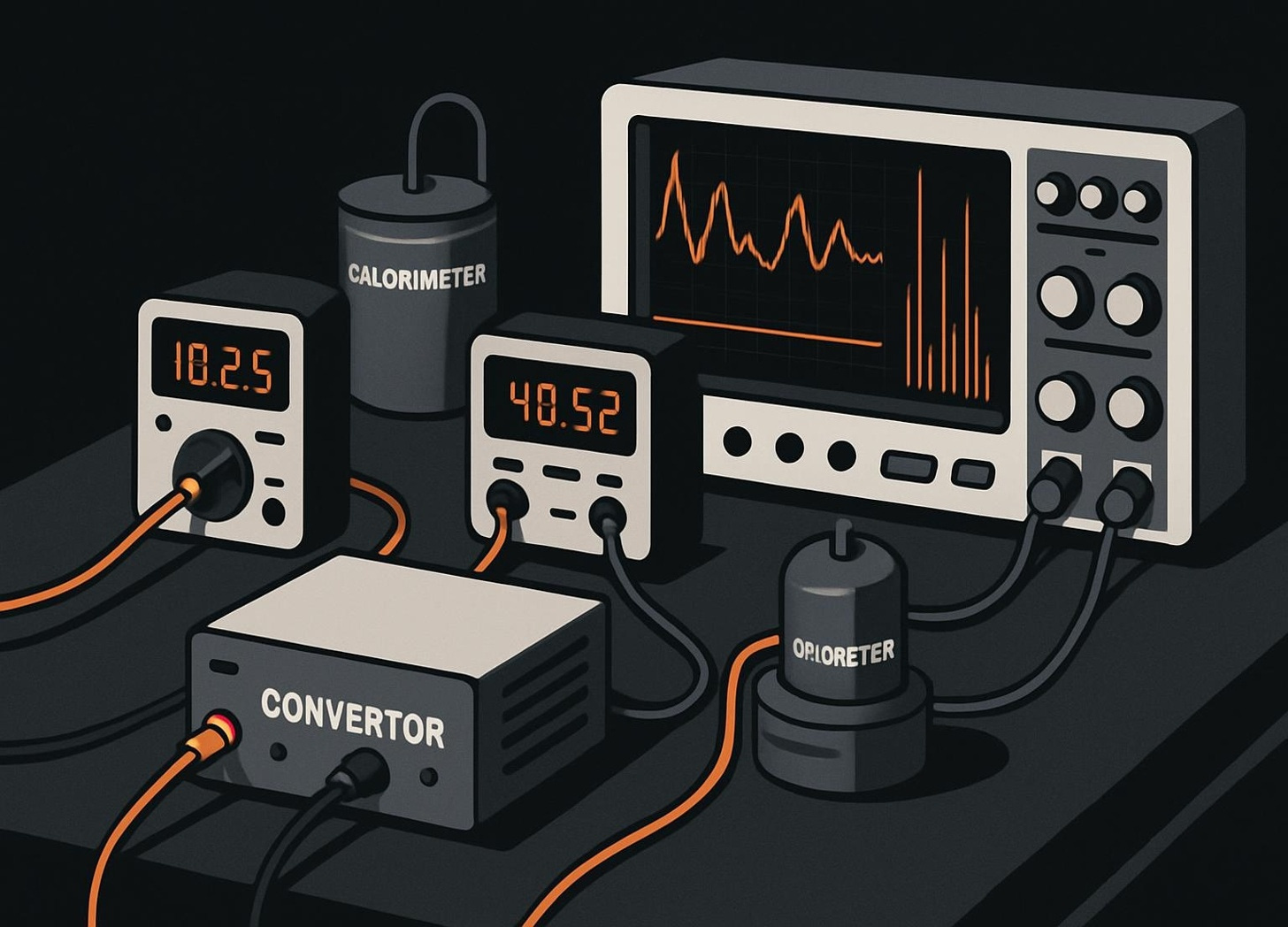Nonlinear Power, Real Gains
Adiabatic shuttles, phase control, and the rigorous tests that separate signal from artifact
⚡ What if one nonlinear circuit shuttles energy with near-zero loss, while another spins into chaos?
Nonlinear dynamics from theoretical physics and applied mathematics could shape how we build resonant and feedback-based power supplies. These systems are more than clever circuits; they tap into mechanisms like self-organization, bifurcations, and even chaos to extract or manage energy with surprising efficiency.
By analyzing how electrical reactance, field coupling, and thermodynamic constraints interact in nonequilibrium regimes, I spot both opportunities and pitfalls. The real challenge is distinguishing genuine performance gains from measurement artifacts, especially when claims border on so-called ‘free energy.’ This guide breaks down the mechanisms, trade-offs, and experimental protocols that reveal where nonlinear electrodynamics meets nonequilibrium energy conversion.
👉 Advanced Rediscovery brings you weekly briefings that cut through the noise with curated insights from my 10+ years of research in AI, extended electromagnetism, the quantum vacuum, and information theory.
In today’s briefing
🔬 Nonlinear chaos and self-organization drive energy transfer in resonant power systems.
🧲 Adiabatic shuttle circuits enable bidirectional, low-loss energy exchange.
🧪 Rigorous protocols distinguish real gains from artifacts in open-system experiments.
💡 Adaptive phase control and bifurcation management improve efficiency.
🤔 Speculative models hint at hidden stable regimes and new test standards.
Nonlinear and Nonequilibrium Dynamics in Resonant Power Systems
Resonant power systems are not limited by linear circuit rules. Instead, they operate in regimes shaped by nonlinear dynamics and nonequilibrium thermodynamics, where feedback, chaos, and self-organization can boost or destabilize energy transfer.
Understanding how field coupling and electrical reactance interact with environmental exchange is key. These mechanisms can either enhance conversion efficiency or create misleading artifacts if not rigorously controlled.
Nonlinear feedback and open-system coupling can generate both chaos and stable energy transfer in resonant power systems.
In my work, I don’t assume traditional power supplies always operate near equilibrium or in closed loops. Nonequilibrium steady-state thermodynamics and nonlinear electrodynamics reveal new performance windows. In these open systems, energy can be shuttled between source and load via adiabatic, phase-coherent processes, reducing resistive losses. For instance, adiabatic oscillator-shuttle circuits use phase-synchronized oscillations to move energy with minimal dissipation.
Self-organization and bifurcation phenomena, like period doubling or chaos, are not just quirks. They show the system’s sensitivity to parameters such as phase, coupling strength, and feedback delay. By tuning these, we can steer circuits toward stable, coherent operation or, if unmanaged, into chaotic regimes that waste energy. Adaptive phase control and decoupling of source and load paths help maintain beneficial asymmetries, preventing self-cancellation and opening up new energy exchange ‘gates.’
Advanced modeling tools, such as spinor-augmented network synthesis, capture hidden bidirectional and phase-rich interactions that linear models miss. These reveal stable operating manifolds and highlight where environmental energy inputs might be miscounted as overunity. Rigorous energy accounting, including environmental boundaries, reframes ‘free energy’ claims as either genuine innovations or artifacts of poor measurement. Embedding nonequilibrium-aware test protocols is essential to validate and replicate high-efficiency designs.
“Nonlinear effects are not just noise—they can be harnessed for efficiency, but only if you know where to look.”
Nonlinear and nonequilibrium approaches open new doors for energy conversion. The challenge is separating real gains from illusions and ensuring every claimed improvement stands up to first-principles scrutiny.
Why it matters
🧠 Nonlinear dynamics and open-system models reveal new efficiency regimes.
🧲 Phase and field asymmetry can boost energy transfer when controlled.
🔬 Rigorous measurement is key to separating real gains from artifacts.
References [1–9]
Adiabatic Oscillator, Shuttle, Circuit (OSC) Integration in Resonant Power Converters
Integrating an adiabatic oscillator, shuttle, circuit (OSC) into a resonant converter lets us achieve two-way, low-loss energy transfer without extra active drives. The secret is in the component choices and the geometry of how energy is shuttled.
By pairing floating-ground capacitors with high-Q inductors and dq/dt-blocked bridges, these systems use nonlinear mixing and phase conjugation. Careful measurement is needed to confirm that energy moves by field effects, not just conduction.
Adiabatic shuttle circuits use precise phase and geometry to move energy bidirectionally with minimal loss in resonant converters.
When designing the OSC stage, we should use floating capacitors and high-Q inductive shuttles to exchange energy between source and load. A dq/dt-blocked bridge allows voltage and field energy to pass while blocking most conduction current. This preserves the adiabatic, low-loss nature of the transfer.
Instead of relying on active nonlinear devices, network-induced impedance modulation creates the necessary nonlinear mixing and phase conjugation. This means three- and four-wave mixing effects can emerge passively, as long as component quality and geometry are optimized. Isolated dual-loop designs separate the voltage and current paths, preventing the source from being back-driven and allowing the load to receive energy via transformer coupling.
Verification is critical. Use voltage and field measurements, phase-conjugate signal tracking, and vector network analyzers to confirm that energy is shuttled by displacement current and phase effects. Harmonic-rich excitation from the converter can stimulate nonlinear mixing, and multiple dq/dt-blocked bridges can broaden the system’s bandwidth while keeping losses low. Special geometric arrangements can further refine phase control and boost nonlinear effects.
“A true adiabatic shuttle circuit passes energy like a baton—no extra push, just perfect timing.”
Adiabatic shuttle integration is not just about clever parts. It’s about precise phase, geometry, and measurement, ensuring true two-way energy flow and minimizing losses.
Why it matters
🔬 Floating capacitors and high-Q inductors enable adiabatic energy shuttling.
🧪 Nonlinear mixing and phase conjugation emerge from network design, not just active devices.
🧲 Rigorous measurement confirms field-driven, bidirectional energy transfer.
References [1, 10–14]
Rigorous Experimental and Control Strategies for Nonlinear Open Power Systems
Open, nonequilibrium power converters require a new level of experimental discipline. Proper boundaries, independent measurements, and clear uncertainty estimates are essential to separating real energy gains from artifacts.
Detecting and managing nonlinear instabilities, like Hopf bifurcations or period-doubling, is just as important. Adaptive control and phase management are my best tools for keeping systems stable and efficient.
Experimental rigor—boundary selection, independent metrology, and adaptive control—distinguishes real energy gains from artifacts in nonlinear power systems.
My first step in rigorous testing is defining boundaries: operator input, load output, and environmental coupling. Each must be measured independently to attribute any excess energy correctly. Precision root mean square (RMS) meters, phase-aware sensors, and calorimetry or field mapping quantify every channel of energy exchange, including environmental inputs.
Uncertainty propagation is critical. Every electrical, thermal, and field measurement carries error, so repeatability and control baselines are needed to anchor results. Spectral analysis, tracking sidebands and phase errors, helps detect the onset of nonlinear instabilities like Hopf bifurcations or period-doubling cascades. Limiter-based feedback and automatic bridge balancing keep the system within observable, correctable ranges.
Control strategies combine phase lead/lag compensation, adaptive coupling, and gain scheduling, all triggered by real-time spectral and phase data. Wideband, high-resolution measurements catch transients and precursors to instability. Symmetry-controlled baselines and asymmetric return paths act as essential controls, distinguishing real environmental energy capture from measurement errors. Adaptive filtering and dynamic adjustments help suppress noise-driven chaos, keeping the system on an ordered attractor.
“Without rigorous control, chaos is just one parameter tweak away. Measurement matters as much as design.”
In open, nonlinear power systems, measurement and control are inseparable from innovation. Only by combining both can we claim real advances in energy conversion.
Why it matters
🔬 Explicit boundaries and independent metrology are essential for open-system tests.
🧪 Spectral and phase analysis detect and suppress nonlinear instabilities.
🧠 Adaptive control strategies keep systems stable and efficient.
References [2, 4–7, 12, 14–24]
Final Thoughts
Nonlinear dynamics and nonequilibrium physics give us new tools for understanding and optimizing resonant power systems. Adiabatic shuttling, phase management, and open-system modeling show that energy conversion efficiency can be improved when traditional boundaries are questioned and new mechanisms are explored.
Assumptions about closed-system limits and linear responses often obscure the role of field coupling and environmental exchange. As advanced measurement and control strategies become standard, the line between artifact and real gain gets sharper. The biggest open questions remain: Which nonlinear effects can be reliably harnessed, and how can I ensure that observed efficiencies reflect genuine energy flows, not hidden errors or misattribution?
Quick Recap
🧠 Nonlinear dynamics boost energy transfer efficiency in resonant systems.
🔍 Adiabatic shuttle circuits enable two-way, low-loss energy flow.
⚡ Rigorous measurement and phase control suppress chaos and noise.
🤔 Nonequilibrium models reveal overlooked mechanisms and test gaps.
👉 Each week you’ll receive one email with ideas, digital material, and tips from my lab. As a PhD engineer, I’ve built the mindset to decode and build upon intricate systems and theories — and I’ll help you do the same.
💡 Challenge these models, test your own circuits, and share your results. A single experiment could redefine what’s possible in energy conversion.
🧑🏼 Follow @drxwilhelm on X Twitter, Substack, Medium, TikTok, YouTube
Glossary
Nonlinear Dynamics: The study of systems whose outputs are not directly proportional to their inputs, often leading to complex behaviors like chaos or self-organization.
Nonequilibrium Thermodynamics: A branch of physics that describes systems far from thermal equilibrium, where energy and matter flow continuously.
Adiabatic Energy Shuttling: A process that transfers energy between components with minimal loss by keeping changes slow enough to prevent heat generation.
Feedback Power Supply: A power supply that uses feedback loops to regulate output, which can introduce nonlinear and chaotic behaviors.
Bifurcation: A qualitative change in system behavior, such as a transition from stable to chaotic operation, often triggered by parameter shifts.
Phase Conjugation: A nonlinear process where a signal is reflected with reversed phase, enabling energy return or error correction in circuits.
Hopf Bifurcation: A specific type of bifurcation where a system’s steady state becomes unstable and gives rise to oscillations.
Heaviside Energy Flow: A theoretical concept describing energy flow in electromagnetic fields, named after Oliver Heaviside.
Spinor-Augmented Network: An advanced circuit model that uses mathematical spinors to capture bidirectional, phase-coherent interactions in electrical networks.
Nonequilibrium Steady State (NESS): A state where a system remains stable while energy or matter flows through it continuously, never reaching equilibrium.
Sources & References
Barrett TW. Oscillator Shuttle Circuit (OSC). 1996.
Moore K; Stockton M; Bearden TE. Electromagnetic Energy from the Vacuum – System Efficiency (ε) and Coefficient of Performance (COP) of Symmetric and Asymmetric Maxwellian Systems. 2006.
Bearden TE. Oblivion – America on the Brink. 2005.
Bearden TE. The Motionless Electromagnetic Generator – Extracting Energy from a Permanent Magnet with Energy-Replenishing from the Active Vacuum. 2018.
Bearden TE. Annotated Glossary. 2000.
Bearden TE. Extracting and Using Electromagnetic Energy from the Active Vacuum. 2001.
Chase C; Arman MJ. Systems and Methods for Generating Coherent Matterwave Beams. 2011.
Bearden TE. Phases of Research and Development and Some Problems. 2007.
Bearden TE. EM Energy from the Vacuum – Ten Questions with Extended Answers. 2000.
Bearden TE. Progress Report on Poynting Current. 1995.
Bearden TE. Patent Regarding Final Purpose of Superconductivity. 1994.
Bearden TE. The Final Secret of Free Energy. 1993.
Bearden TE. Practical Overunity Energy Devices. 1994.
Kelly PJ. Practical Guide to ‘Free Energy’ Devices. 2020.
Herbert RD. Zero-Inertia and Inertia Manipulation in the Chronoflux Framework. 2025.
Hooper WJ. New Horizons in Electric, Magnetic and Gravitational Field Theory. 2015.
Bearden TE. Engineering the Active Vacuum – On the Asymmetrical Aharonov–Bohm Effect and Magnetic Vector Potential A vs. Magnetic Field B. 2006.
Dollard EP. True Electromagnetism of Nikola Tesla.
Newton MI; Morris R. Advances in Electronics Prompt a Fresh Look at Continuous Wave (CW) Nuclear Magnetic Resonance (NMR). 2017.
Forbes A. Free Energy Friday – Dirac Holes [video]. YouTube.
Bearden TE. Gravitobiology – A New Biophysics. 1991.
Owens J. Phase Relationships and Harmonics in the Steven Mark Toroidal Power Unit. 2007.
Bearden TE. Vacuum Engines and Priore’s Methodology. 1995.
Haramein N. Plasma Flow Interaction Simulator. 2012.






This is why it’s so hard to engineer. You’re extracting energy from steady chaos. Seems a lot like trying to engineer biology to do what you want from my view. There’s so much going on underneath the hood here that we can’t see and don’t understand that it verges on magic or “fake science”
Power amplification is not creation but coordination. A local perturbation invoking a global response. Control emerges when the field, not just the point, is defined.